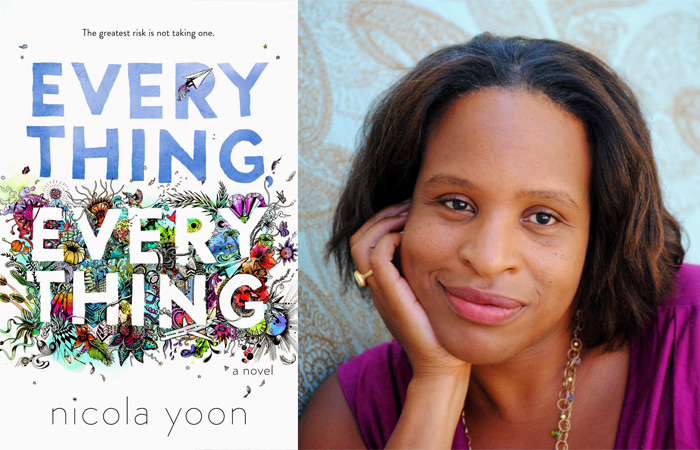Everything, Everything Author Nicola Yoon Talks Helicopter Parenting, Artistic Collaboration, and Finding Humor in Tragedy
 An exhilirating and memorable debut novel that has generated a lot of buzz, including a film option at MGM, Everything, Everything is about Madeline Whittier, a severely allergy-prone teenage girl who has spent her entire life indoors—in a proverbial “bubble”—owing to her life-threatening condition. With only her physician mother and full-time nurse, Carla, as company, her experiences have been severely limited. But when intriguing new neighbor Olly moves in next door, everything Madeline has accepted about her situation explodes.
An exhilirating and memorable debut novel that has generated a lot of buzz, including a film option at MGM, Everything, Everything is about Madeline Whittier, a severely allergy-prone teenage girl who has spent her entire life indoors—in a proverbial “bubble”—owing to her life-threatening condition. With only her physician mother and full-time nurse, Carla, as company, her experiences have been severely limited. But when intriguing new neighbor Olly moves in next door, everything Madeline has accepted about her situation explodes.
Last week we revealed 6 Reasons You Need to Read Everything, Everything, and today, to celebrate the book’s imminent arrival, we have author Nicola Yoon here to discuss how the story came about!
The combination of straight narrative and “artifacts” such as health records, texts, journal entries, and ticket stubs serves to make your novel even more realistic. How did you decide which portions of the story would be best told as narrative, and which worked better as artwork or objects?
I really tried to focus on making the prose as spare and impactful as possible. I wanted the reader to get a feeling for the nontraditional way Maddy views the world. If there was a section of prose that I thought could be made into an illustration or a list or a definition or something, I went for it. It didn’t always work, and I have quite a few “outtakes,” but I tried to include as many of these types of elements as I could.
Because Madeline spends a large portion of the story inside, did you ever feel claustrophobic while writing the book? Did you ever force yourself to stay indoors for a certain length of time to get a taste of being housebound?
Well, I started writing the book when my daughter was four months old. At that point I’d spent a lot of time indoors with her, so maybe I was feeling claustrophobic and didn’t realize it!
Olly is skilled in parkour. Do you or anyone you know practice it? Did you watch any YouTube videos about it? If so, did that research send you down any interesting rabbit holes?
I spent probably an unhealthy amount of time watching parkour videos on YouTube. They are SO MUCH FUN. I really wanted to try some moves myself but I’m waaaaaaay too clumsy for that!
Can you share a little bit about what it was like to collaborate with your husband, who drew the terrific artwork in the book?
It was really wonderful! We’ve often talked about collaborating on a project, but this was the first time we were able to do it. He’s so talented and easygoing that it was mostly smooth sailing. In terms of logistics, I’d usually draw a terrible no good version of an illustration and show it to him. We’d then discuss what I was trying to accomplish, and then he’d draw me something beautiful. I am very lucky to get to work with him.
Articles on helicopter parenting and its potential for creating adults who don’t have confidence in themselves have been popping up lately. For me, your book really encapsulated an extreme—yet very real—version of helicopter parenting, the idea that parents are obligated to keep their children safe from, well, everything! To what extent do you think this is a problem, and did it influence any part of your writing?
I do think helicopter parenting can be a problem. When my daughter was born, I was really overwhelmed by my need to protect her from everything (catching a cold, eating dirt, bumping her head). I’m sure a lot of new moms feel like this. Newborns can seem so fragile. As my daughter has grown (she’s 3 now), I’ve had to fight my protective instincts so that she can become independent and self-confident. I’m learning that the only real way to protect her is by letting go.
Everything, Everything is beautifully written, and one of my favorite aspects of the story is its humor. The subject matter is certainly sad in many ways, yet Madeline’s outlook, and her interactions with Olly and Carla, contain true joyfulness. Was it important to you to balance the darkness and lightness of the story? Was it a conscious choice, or did it stem from the characters as you went along?
Thank you! Yes, it was definitely important to me to have some humor. Madeline is in a tragic situation, but she’s fundamentally an optimistic person. At a particular moment in her youth, she consciously decided she either had to make peace with her circumstances or resign herself to a life of misery. She chooses to embrace and find joy in the world as she knows it.
Did you end up surprising yourself with any of the twists and turns of the story, or were they built into the premise from the beginning? Was there ever a different version of the book that came to a different fork in the road?
Strangely, I knew exactly how I wanted this story to end from the very beginning. That’s not usually the case for me, but this story knew what it wanted to be.
Everything, Everything goes on sale tomorrow, and is available for pre-order now.